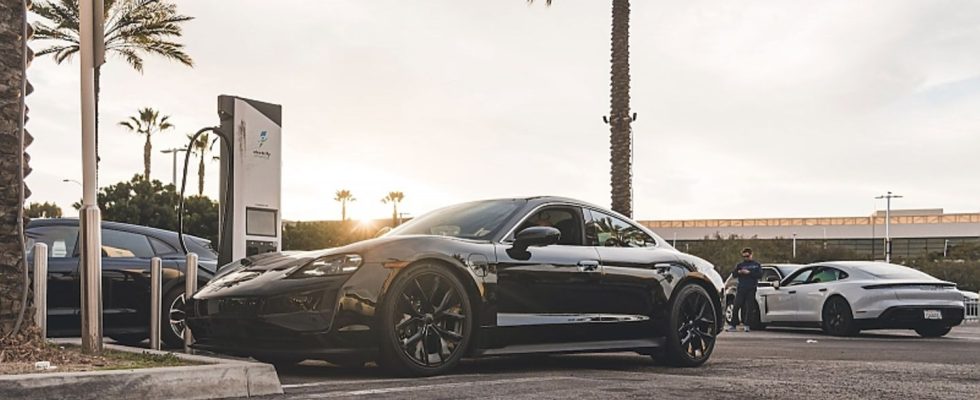Report: Range test in the new Porsche Taycan
To the last meter
Porsche Taycan testing 2024
© press-inform – the press office
The facelift of the Taycan will reach customers in the second quarter of 2024. Before the Porsche fans can clap enthusiastically, we took an exclusive range test with the new electric model from Zuffenhausen. Los Angeles to San Diego and back – quickly on the road without a charging stop.
Visually, not much will change as a result of the facelift, which will celebrate its premiere very soon. Although the black Porsche Taycan, which is going on an extensive test lap today on the route between Los Angeles and San Diego, is a prototype, the camouflage is apart from translucent foil on the headlights and a few dark stickers on the front apron and the LED light strip, there wasn’t much left. The slightly changed front looks good on the refreshed Taycan, because the headlights no longer look like sad-looking eyes, but rather appear more straightforward and contemporary than the carry-over lights of the early study, which found their way into the series predecessor. Apart from that, there are no significant differences inside or out between the previous model and the new version, which not only the development department in Weissach has great expectations of. When it comes to details about the drive and battery pack in the underbody, Porsche is still holding back. However, it is no secret that the previous gross capacity of 93.4 kWh for the facelift has received a significant increase in size and technology over the 100 kWh mark.
After starting in the port town of Marina del Rey, southwest of Los Angeles, this morning we head on the usual busy streets and highways to the Mexican border. From San Diego, you should ideally head north back to your starting point without a charging stop. Behind the wheel, with an identical Taycan interior, not everything is the same, because the digital instrumentation tubes, unlike before, provide more information about details such as charge level, battery temperature and currently possible charging speed. The Taycan, with its battery pack bulging, threads its way inconspicuously into the morning commute to the south. Via Interstate 405 and later I-5, the privileged HOV lane for electric cars and vehicles with at least two occupants goes past the usual traffic jams around cities like Long Beach, Santa Ana and Irvine on the left until the traffic clears in the hinterland of Orange County calmed down somewhat. The travel pace becomes increasingly brisk and despite quickly meandering through, the real consumption levels off at around 32 kWh / 100 miles after the first 100 miles (160 kilometers); the equivalent of almost 20 kWh per 100 kilometers. Not a bad value for a luxury four-door car that weighs over 2.3 tons and brutally presses you into your seat when you tap the accelerator pedal. Obviously not exactly the basic version of the upcoming Porsche Taycan, as some body details indicate that huge electric motors on both axles provide immense thrust. So far, the Porsche Taycan Turbo S with 560 kW / 761 hp with 1,050 Nm maximum torque was the cherry on the range. For all Taycan versions there is likely to be a significant improvement in terms of battery pack and performance. But today it’s on track.
After a few detours around the Naval City of San Diego, a look at the on-board computer shows an average speed of 66 miles per hour (almost 110 km/h). After around 150 miles of test drive and the usual ups and downs in the south of the sunny state of California, consumption leveled off at lunchtime at 30.2 kWh / 100 miles. That’s 18.7 kWh per 100 kilometers and thus the certainty that no charging stop would be necessary for the return trip to Los Angeles. But a later stopover in Torrance, 30 minutes south of the metropolitan area of LA is planned, because the new Taycan is supposed to show at a fast charging station that it can also shine while stationary. So there is an afternoon stopover at the fashion mall there and after plugging in the charging plug, the number 299 flashes on the Electrify America charging station, because 304 kW. While the Porsche Taycan and Audi Etron GT’s charging power of up to 270 kW on the hypercharger was more than impressive, the revised generation two Porsche Taycan now goes a step further. The charging station’s digital display shows a charging output of 319 kilowatts at 23 percent charge level – and the plateau is set. Only beyond 66 percent does the number fall to 286, 250 and then 234 kilowatts – most vehicles don’t even offer that as a maximum speed. After less than 20 minutes, the battery pack went from 11 to over 80 percent. So we return to the hotel satisfied. Tomorrow it’s back on the road for the final tests before it gets to the customer. And then it’s not just about the last mile. But this is where the new Taycan can really shine.

